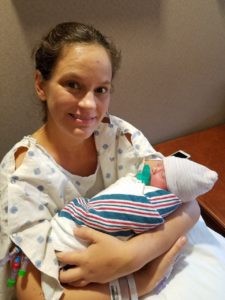My surprise baby came a month early.
I was 34 weeks pregnant, at the beach with my husband, our three children, and my parents, when I started feeling bad. I was having mild, but regular, contractions. I was tired. I was so thirsty. I was beyond uncomfortable. I chalked it up to being too old to chase a 14-month-old around the beach while heavily pregnant.

When we got home, I had a radiating pain in my shoulder blade. It became so excruciating that I slept sitting up and cried in pain. Heat, massage, ice—nothing touched it. I now know it was referred pain from my liver.
My blood pressure slowly crept up, and I monitored it per my OB’s instructions, but it never reached an alarming stage.
I developed excessive thirst. I thought it was normal—why wouldn’t you be hot and thirsty in the late stages of pregnancy in the middle of a Texas summer?! I started getting up in the middle of the night to eat watermelon and drink ice cold water. A Yeti cup with ice water was always by my side in those last days. I also started drinking Vitamin Water because I knew I needed the extra potassium. We couldn’t keep enough stocked.
I instinctively knew I would never make it to the end of my pregnancy and deliver full-term like I did with my daughter the year before. I said it to others often: “There is no way this baby is going to make it until August.” I could feel his head so low. I had prodromal labor with my daughter and figured the same was happening again, but this time I was prepared not to be anxious about it.
The morning of July 6 I woke up with a headache. I don’t get random headaches. I knew to check my blood pressure and watch it closely throughout the day—and it crept up. At noon I developed a nosebleed. I don’t get nosebleeds. Dr. Google told me that nosebleeds are not uncommon later in pregnancy because of the increased blood flow in your body. It stopped, but I still didn’t feel right. A few hours later the nosebleed started again and would not stop. It was a heavy flow of blood, soaking Kleenex after Kleenex. I was trying to talk on the phone with my sister-in-law and had my head tilted back the entire time gurgling blood. Finally, after about 30 minutes of this, I told her, “This is crazy. Something is not right.”
I called my parents, who came over to stay with our 15-month-old daughter while I went to Labor & Delivery triage to get checked out. I took my time getting ready, ate dinner, packed a little toiletry bag “in case they keep me overnight,” and got my baby girl to bed. I had no idea that would be my last night with her for days and that I wouldn’t be able to hold her again for weeks.
Upon arrival at triage around 7:30 P.M., the staff called my OB and started running labs and tests. My nosebleed was still going full force. My OB was not on call that night, but she showed up. That should have been my first clue. She told me later when she learned I was there, she knew something was wrong because I’m not a whiner or a complainer. She came right away. The results of the first set of labs came back. I didn’t understand what they were or what they meant, but I sensed something was wrong. She asked me with a slight bit of incredulity in her voice, “Don’t you know you are in labor? Don’t you feel those contractions?” Of course I did—and I had for at least a week prior—but I was only 35 weeks!
My OB gave me a series of alarming news: I was going to need to deliver the baby that night. As quickly as possible. The safest way for me to deliver him was vaginally. No big deal, I thought. After all, I’d delivered a full-term baby merely 15 months earlier. But wait, I couldn’t have an epidural. And if the baby didn’t come fast enough, I would have to have an emergency C-section.
The understanding of mine being an emergent situation became clearer and clearer. My OB broke my water, and we hoped that my labor would progress quickly. The next couple of hours start to blur together in my memory. The things that I recall distinctly are: texting my parents and my sister-in-law and updating them in a very nonchalant manner; my OB being on her phone fervently trying to track down a hematologist to consult on my case (I knew I was having blood clotting issues, but did not fully understand it or appreciate its critical nature as it happened); freaking out at the prospect of delivering naturally with no epidural (in retrospect, that was the least of my worries); and being in awe of my triage nurse, given she was also very pregnant.
My baby boy was not coming fast enough. This meant an emergency C-section under general anesthesia. I remember feeling sad when I realized that my husband could not be in the room when our son was delivered. Days later, I realized that I hadn’t really been present either. I have zero memory or experience of my son’s birth, and that haunts me to this day.
The anesthesiologist arrived, as well as the hematologist, and the gravity of the situation became fully apparent. I was going to need a lot of blood transfusions and plasma too. Having the blood there and readily available wasn’t a precaution, but a necessity. I signed all of the consent paperwork and waited for my new blood to arrive.
My husband stayed by my side. Our son was about to born. He had no name. We had discussed a few variations, but hadn’t settled on one just yet. I thought I had some time, but apparently time was now up. We decided to name him after our family priest, who had passed away just a few months prior and was very special to us.
My OB came to me and my husband and asked us to pray with her before we headed into surgery. Without hesitation, the three of us held hands and prayed for protection and strength. I had been in problem-solving lawyer mode for the past few hours telling myself very objective things like, “You never wanted a C-section, but this is the solution so you don’t continue to become ill,” and “Yes, it sucks that Nik won’t be in the room, but you might bleed to death, so if you have to be under general anesthesia, it is what it is.” However, when we stopped and prayed I truly, truly realized how serious this situation was and that even my unflappable OB was scared.
As I lay on that table in the OR about to give birth in a fashion I’d never imagined, I also could have never imagined what was waiting for me on the other side of that delivery.
I came to learn that I’d developed Acute Fatty Liver of Pregnancy (AFLP) with a DIC (Disseminated Intravascular Coagulopathy, for you medical nerds), which in my case meant serious bleeding, including bleeding that starts spontaneously (my nose). AFLP is a rare liver syndrome that is fatal to the mother unless the baby is delivered quickly after onset. It occurs in the third trimester or early postpartum period. Many experts believe this syndrome is on the same spectrum as HELLP syndrome. Early diagnosis of AFLP is difficult because it shares characteristics with other common conditions such as preeclampsia and viral hepatitis. The exact cause is still unknown, but it is believed to be caused by something in the mitochondria of the baby’s DNA that overloads the mother’s liver. It occurs in 1 out of every 15,000 pregnancies, and interestingly, most often with male fetuses. In the past, the mortality rate for mothers was as high as 75%; for babies, 85%. Now, with prompt diagnosis and treatment, those mortality rates have dropped to 18% and 23%, respectively. It’s still amazing and frightening to think that in this day and age of modern medicine, nearly a quarter of pregnant mothers like myself die from this complication.
My Baby T was born after midnight weighing 4 lbs. and 14 oz. He was perfect and healthy and did not have to spend one minute in the NICU. He went to the nursery with his daddy.

I, however, woke up in the ICU several hours later.
I thought I was there because I’d had a C-section. Morphine was my friend, and I didn’t have a care in the world. I know from my research that psychosis is a common symptom of AFLP. In retrospect, there was definitely some of that going on. I texted a few friends telling them the baby had been born, but with no mention of me being so sick. I even emailed my boss and a couple of co-workers—yes, from the ICU—and said that just like last time, I’d had my baby on a Friday so I could be working again on Monday.
I didn’t see Baby T for a couple of days. The nursery nurse attempted to wheel him in to see me in the ICU. She tented him completely so I could at least see him, but the ICU staff wouldn’t allow it. This didn’t phase me one way or the other. I had no sense of urgency to see or hold him. Eventually I was moved to the L&D active labor wing so I could have the round-the-clock care I needed. It was here that I started to realize how sick I was and that I was not out of the woods. I could tell by the looks on the nurses’ faces and how they talked to each other about me at shift change that I faced some serious stuff.
A PIC line was placed in my arm so I could receive vials upon vials of medications every few hours without having to be stuck repeatedly. The scar still lingers as a regular reminder. I had a catheter in for days because my body was releasing an unbelievable amount of fluid. I gained 40 (yes, FORTY!) pounds of fluid after delivering the baby. My legs swelled up to an unrecognizable size; the tops of my feet were huge. I had to wear compression stockings around the clock, and the poor nurses struggled with all of their might to hoist them up on me. I was jaundiced—my skin and eyes were both so yellow. My pelvic area was so badly bruised—from all the blood draining into my abdominal cavity—that it looked as though someone had taken a baseball bat to my abdomen. This area changed color over the next couple of weeks to a near black. I never took a picture because I did not want to remember it.
My husband finally asked me if I was ready for him to bring me the baby. I remember saying, “Sure, might as well do it now.” The remainder of the week in the hospital was emotionally difficult. I vividly remember struggling with not being able to be with Baby T often enough to nurse him consistently. I was advised not to pump—the stress on my body would be too much. I needed to rest and focus on myself. We did nurse the few times I had him in my room. My supply dwindled for the next couple of months due to our separation at birth and all of the steroids I was on for many weeks, and eventually I had to give up nursing him.

By Day #5 in the hospital, I was desperate to get home. I was becoming depressed. I missed my 15-month-old. I wanted out of the prison of my hospital room and the prison my body had become. I packed my bags and waited for the latest lab results (which I had taken several times a day to monitor my liver) to confirm I was just good enough to be discharged. I was devastated when my OB came to tell me that she really wanted me to stay one more day to get a certain level under control. If I left, I knew it would be against medical advice, and I knew I couldn’t do that, but the reality of my situation weighed so heavily on me I could hardly stand it. My mom wheeled me outside of the hospital for some fresh air. I watched people walk in and out of that hospital freely with a bitter heart. This memory of helplessness drives me every single day to appreciate my body and my health.

I went home the following day. Recovery was a slow-going, with a lot of appointments with the hematologist and my OB, high doses of steroids, struggling to nurse my little guy, and learning to walk with legs the size of tree stumps. Over time, all of these issues resolved. My C-section scar took more than two months to heal and close due to the steroids. My husband had to clean and pack my wound daily for weeks. Eventually I came to do it myself. What doesn’t kill you, truly does make you stronger.

The hematologist cleared me from further treatment once I tapered off the steroids. All of my liver functions gradually returned to normal. The wound healed. The yellow jaundice in my eyes and skin faded. Now, more than a year later, there is very little physical evidence of what happened to our family, but it’s all still there in my heart and mind.
I struggled for months with how to express my gratitude to my OB. She saved my life. I’m so grateful that I had the opportunity to share my appreciation with her during one of my appointments. We are forever connected by this traumatic experience. At some point she told me she’d had one other patient in all of her years of practice who developed AFLP. That mother was in the ICU for months. I’m so truly blessed to have had the level of medical care that I did on that night.
Today, I am the picture of health. Baby T is thriving and enjoying being the baby of our family. My husband was a rock during those early days, taking care of all of the other children and our household. My mother stepped in, as mothers do. All of our family rallied around us. My close friends at work took the pressure off of me and allowed me to heal. And I learned to accept help. I warded off the depression by allowing visitors to come over instead of shutting the world out like I wanted. I told my story. I allowed myself to cry. My traumatic birth story has been heavy on my heart for a year, but now, finally, the weight is lifting.












I also experienced AFLP with my first child. We celebrated his 10th birthday this past February and it’s amazing how such a special day reminds us of the day my husband almost became a widower and a dad. Seeing the picture of your legs brings back sooo many memories. Our stories are familiar but also very different. My signs were thirst but I had many others too, I now know it was my liver shutting down.
I have also never met anyone with the same condition and would love to connect and share our similar stories!
Thank you so much for reaching out and sharing! It means the world to me know someone else out there experienced the same condition. I’m so grateful to connect with you!